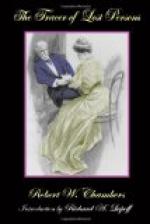“Under it, again, we have a repetition of the first symbol meaning I, and a repetition of the second symbol, meaning ‘Meris, the King.’ Then, below that cartouch, comes a new symbol,
[Illustration: Glyph]
which is the feminine personal pronoun, sentus, meaning ‘she’; and the first column is completed with the symbol for the ancient Egyptian verb, nehes, ‘to awake,’
[Illustration: Glyph]
“And now we take the second column, which begins with the jackal ideograph expressing slyness or cleverness. Under it is the hieroglyph meaning ‘to run away,’ ‘to escape.’ And under that, Mr. Burke, is one of the rarest of all Egyptian symbols; a symbol seldom seen on stone or papyrus,
[Illustration: Glyph]
except in rare references to the mysteries of Isis. The meaning of it, so long in dispute, has finally been practically determined through a new discovery in the cuneiform inscriptions. It is the symbol of two hands holding two closed eyes; and it signifies power.”
“You mean that those ancients understood hypnotism?” asked Burke, astonished.
“Evidently their priests did; evidently hypnotism was understood and employed in certain mysteries. And there is the symbol of it; and under it the hieroglyphs
[Illustration: Glyph]
meaning ‘a day and a night,’ with the symbol
[Illustration: Glyph]
as usual present to signify force or strength employed. Under that, again, is a human figure stretched upon a typical Egyptian couch. And now, Mr. Burke, note carefully three modifying signs: first, that it is a couch or bed on which the figure is stretched, not the funeral couch, not the embalming slab; second, there is no mummy mask covering the face, and no mummy case covering the body; third, that under the recumbent figure is pictured an open mouth, not a closed one.
“All these modify the ideograph, apparently representing death. But the sleep symbol is not present. Therefore it is a sound inference that all this simply confirms the symbol of hypnotism.”
Burke, intensely absorbed, stared steadily at the scroll.
“Now,” continued Mr. Keen, “we note the symbol of force again, always present; and, continuing horizontally, a cartouch quite empty except for the midday sun. That is simply translated; the midday sun illuminates nothing. Meris, deposed, is king only in name; and the sun no longer shines on him as ‘Ruler of Upper and Lower Egypt.’ Under that despairing symbol, ‘King of Nothing,’ we have
[Illustration: Glyph]
the phonetics which spell sha, the word for garden. And, just beyond this, horizontally, the modifying ideograph meaning ‘a water garden’;
[Illustration: Glyph]
a design of lotus and tree alternating on a terrace. Under that is the symbol for the word ‘aneb,’




